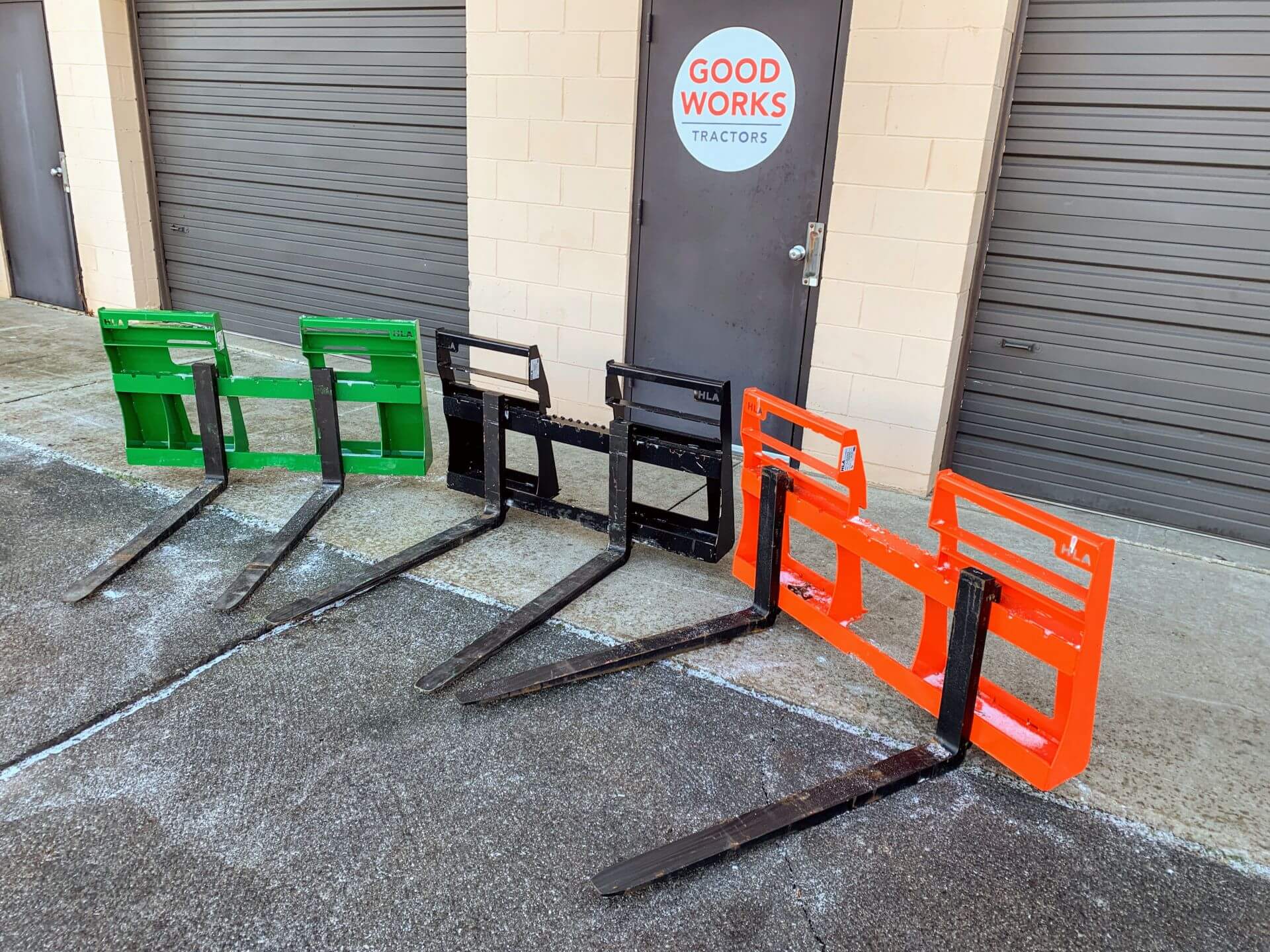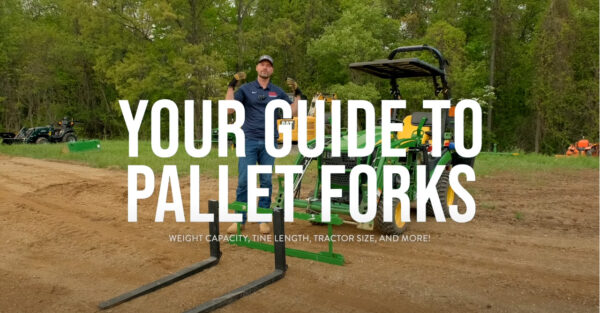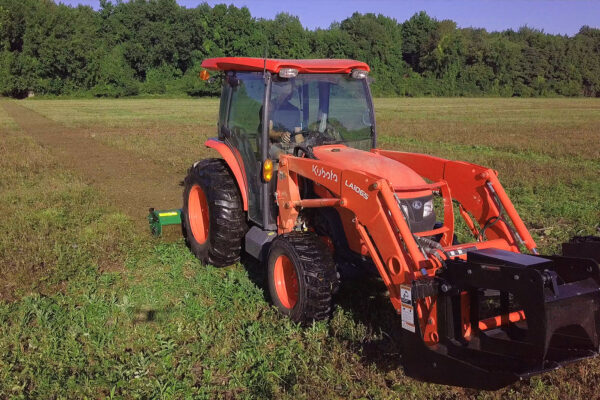Picking out the right pallet forks to fit your tractor should be easy! However, there’s nothing worse than making the wrong decision and not realizing until it’s too late. So, let’s get you the information you need ahead of time so you get the right pallet forks for your tractor the first time around! You might be thinking “I don’t have any pallets around me, so these things are useless”. I’d like to prove you wrong, haha!
A good set of pallet forks on your tractor may just be the handiest and most used attachment that you wind up owning. Of course you can move pallets around. Maybe you store your attachments on pallets to easily organize or load up your bags of mulch, stone, and salt pellets to quickly transport. Pick up logs, brush piles, boulders. Need to lift the truck cap off your truck? Get a set of forks (maybe some fork extensions too). Hang a deer from them for butchering, hang your mower deck for cleaning. Move heavy appliances once outside, support posts and beams while being installed. The uses for pallet forks can go on and on!
One thing you won’t see us sell are clamp-on forks. Yes, they are certainly cheaper. There is far less material, so that goes without saying. However, they clamp to the bottom leading edge on your bucket. This pushes the load you want to carry much further away from the tractor meaning you will lift much less. Also, all of that stress is concentrated on a couple of points on your bucket edge meaning it’s possible to damage it. Clamp-on forks are known to slip and slide around so they could fall off or you could drop the load you’re carrying. We have sold many sets of “real” pallet forks to customers upgrading from the clamp-on style.
Okay, now that we’ve made the case for forks, let’s get you the details on finding the right set for you. You want to understand how they connect to your loader, how much weight you need to lift, the right fork tine length, and how to safely use them. I do need to mention that we sell and ship tractor attachments all around the country! This means that we can ship the forks right to your house! See all we have to offer at Good Works Tractors!
Do you prefer to watch us explain it instead? Watch the video below!
What style of quick attach do you have? Most common will be the JDQA or SSQA. JDQA stands for John Deere Quick Attach. It has two hooks on top, two pins on bottom. No other brands have this style of connection, so if you don’t own a John Deere, then you won’t have it. The other very common quick attach is called SSQA which stands for Skid Steer Quick Attach. This is typically two levers that release or secure two pins through the bottom plate. Now, it is possible that you don’t have a quick attach at all. This is called a pinned bucket. You may also have a less common quick attach from Yanmar or LS who both offer SSQA as well as their own proprietary quick attach. We carry the JDQA and SSQA versions. However, we can custom order the other versions as well. Expect a longer lead time and a higher price.
How much can you lift? This is a two part answer. First, your loader will have a rating telling you how much it will lift. This is very confusing as tractor manufacturers want to tell you the absolute maximum that their loader will lift which is not actually possible in the real world. It will typically be measured at the end of the loader arms (without a bucket, pallet forks, grapple, or anything else on it). No one is effectively using their loader without an attachment on it and no one is picking up all their weight at the end of the loader arms! Think about it, whether a bucket, grapple, or forks, the center point of the weight you’re picking up is 12-36″ out in front of the loader. The further in front you go, the less weight you’ll pick up. So, while a tractor may brag about a 1,500 pound lift capacity on their loader, the real world weight it can lift and safely move around is likely closer to about 75% of that or around 1,100 pounds.
If you’re with me so far, then this next part should be easier. You’ll see a set of standard duty forks rated to lift 2,000 lbs. Fork companies rate them to lift 2,000 lbs when the load is 24″ from the base of the fork. An actual real world piece of data! So, your loader would likely need a manufacturer rating of well over 2,500 lbs to ever be near this limitation. This means that there isn’t a compact tractor on the market that ever needs something beefier than a set of standard duty forks. We’ve sold standard duty forks to bigger tractors as well without issue. They are definitely including plenty of margin in their rating. The same concept applies to the Ultra Light Forks as well as the Heavy Duty Forks.
What pallet fork tine length is right? Well this one is definitely open for interpretation. With what we’ve discussed, we know that the further away from the loader, the less we can lift. This means longer tines could potentially mean we’re lifting less weight. Longer tines are also heavier. However, longer tines may also be easier to see from the operator’s seat. You can also stack more brush on them too. Shorter tines are a bit cheaper, easier to store, and lighter. I think fork manufacturers should simplify things and only offer one or two choices instead of three or four choices in tine length. It just isn’t the end of the world and not something I’d lose sleep over.
How to safely use pallet forks? As with any attachment, take it easy! Go slow stay in low range on your tractor. More and more dealers are starting to properly ballast tractors, but don’t depend on them! Read your manual. You’d be surprised how much counter weight is needed for even a small tractor like a John Deere 1025r! You need over 1,000 lbs on the backside of your tractor when using the front end loader. That’s with the bucket, pallet forks, or a grapple! That’s why we focus on safety. Typically, you will need more than one form of weight to achieve the minimum required. So, order your ballast weight from us at the same time as your forks and you’ll be good to go! Shop ballast weight solutions here!
So, the last thing to do is pick the forks that are right for you! Below is a cheat sheet to cover some popular models of tractors. If you don’t see your tractor mentioned, just look up the specs of what we do mention and see if it is similar in size to your own tractor. A few hundred pounds one way or another is not going to be a big deal with a set of forks. Thank you so much for stopping by and I hope you found this guide helpful!
HLA Ultra Light 900 Lb Rated Pallet Forks: Perfect for subcompact tractors like the John Deere 1025r and Kubota BX Series. Also great for small compact tractors like the John Deere 2025r, 2038r and Kubota LX Series.
HLA Standard Duty 2,000 Lb Rated Pallet Forks: A great fit for the rest of the compact tractor world. The John Deere 3e, 3r, and 4 Series. The Kubota L, Grand L, and MX Series.
HLA 4,200 Lb and 5,500 Lb Rated Pallet Forks: Designed for big machines such as skid steers, utility tractors, and loaders!



